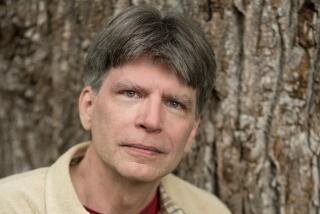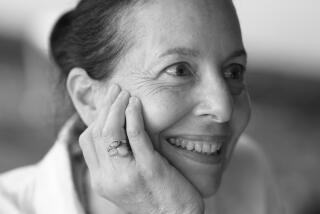At home on alien worlds
PORTLAND, ORE. — Forest Park is one of the largest patches of urban wilderness in the United States, and the Victorian homes and gardens nearby create an air of Tolkienesque enchantment. Right around here in fact, one of Tolkien’s heirs labors in a century-old house.
“I agree with Tolstoy that the best way to tell a story is invisibly,” Ursula K. Le Guin says. “But I also hear what I write, and I think if you can’t read it out loud, there’s something wrong with it.”
It’s hard to find a literary career as varied as Le Guin’s. At 79, she’s worked for half a century on the ever-shifting frontier between literary and genre writing, a line she has helped redraw with her elegant prose.
Le Guin has long been celebrated as a pioneer of young adult literature. Just two weeks ago she won a sixth Nebula Award for her YA novel “Powers.” With last year’s death of Arthur C. Clarke, she is also arguably the most acclaimed science fiction writer on the planet. But she’s more.
Her 1968 novel, “A Wizard of Earthsea,” concerned a school for wizards; the National Endowment for the Arts made the book a selection of its program the Big Read.
“I think Le Guin is vastly underrated by the critical establishment, which continues to stereotype her as a genre writer,” says former NEA Chairman Dana Gioia. “She’s become a deeply serious writer without losing the vitality and the excitement of popular literature.”
Her admirers include Salman Rushdie as well as the generation working genre’s borderlands: Michael Chabon, Neil Gaiman, David Mitchell, Jonathan Lethem and Kelly Link.
For all this, she is in a curious position: She’s achieved these things almost entirely on the basis of work now three and four decades old. “She was the big thing for almost 20 years,” said Donna White, author of “Dancing With Dragons: Ursula Le Guin and the Critics.” “The 1970s and 1980s were her big decades; she was revered by scholars. But now people have moved on.”
Her status is further confused because of the variety of fields -- YA, fantasy, science fiction, essays -- in which she writes.
But don’t count Le Guin out. Her recent “Lavinia,” a novel set in the world of Virgil’s “Aeneid,” was compared by Publishers Weekly to Robert Graves’ “I, Claudius.”
Le Guin’s early years help explain her abiding concern: Is there such a thing as a stable human nature? She grew up in Berkeley, the daughter of Alfred Kroeber, a founder of modern anthropology, and Theodora Kroeber, author of “Ishi in Two Worlds,” about an American Indian who had outlived his tribe. Her childhood, which included summers at a family ranch in Napa, was full of reading, storytelling and visits from European intellectuals and Native Americans.
“I was privileged,” she says, “to know the kind of people that most American kids, most bourgeois white kids, don’t.” She was raised “as irreligious as a jack rabbit.”
Eric Rabkin, who teaches at the University of Michigan, sees her work as profoundly shaped by her exposure to alien cultures as well as her father’s ambition to find as specifically as he could the time and place from which Western civilization had sprung.
“There’s a kind of romance to that view,” Rabkin says. “That once upon a time, the worst antagonisms were merely inter-familial -- that basically we’re all alike and trustworthy. And I believe she grew up in a family in which that was considered not a fantasy but a scientific fact.”
As a kid, Le Guin thought science fiction was corny.
“When I was about 11,” she recalls, “my brother and I used to buy Astounding [and other pulps]. We sneered at a lot of it. We were pretty arrogant kids.”
Then, around age 30, a friend drew her attention to Cordwainer Smith and Theodore Sturgeon. “I thought, ‘Oh, look at that. That could be fun.’ ”
Some of the SF faithful hold it against Le Guin that she prefers Borges and Virginia Woolf to what she calls the “white man conquers the universe” tradition of Robert A. Heinlein. Yet science fiction clearly fit this daughter of anthropologists. Here, she wrote, “All alternatives are thinkable. It’s not a comfortable, reassuring place. It’s a very large house, a drafty house. But it’s the house we live in.”
From the late 1960s to the early 1970s, Le Guin went on a streak inspired by her interest in thought experiments and a Taoist concern for equilibrium.
The ferment of the Vietnam War and Watergate, of feminism and civil rights, stimulated her imagination: She took these concerns and transmuted them, setting them on other planets and in other centuries. This was an artist working at the peak of her powers.
All her books of this period have powerful images that suggest her importance to the environmental movement: a forest world, a harsh desert moon, flooded cities, island planets.
Her breakthrough novel was “A Wizard of Earthsea,” the coming-of-age tale of a young sorcerer who possesses great power but has also, through reckless pride, done damage to the world. After it came two undisputed SF masterpieces: “The Left Hand of Darkness” and “The Dispossessed.”
Le Guin started writing the former as a book about a planet caught in an ice age. It evolved into the tale of a race with no fixed gender: Every month, people go through a process in which they take on masculine or feminine characteristics.
This world is fully imagined, its texture coming from myths and folk tales wrapped around the narrative.
“I’m following Tolkien’s prescription for fantasy creation,” Le Guin says, sitting in her living room. “You are making a world out of words, and the only thing that’s going to hold it together is its inner consistency.”
“The Dispossessed” was equally celebrated; it’s a lively novel of ideas about a planet resembling the Cold War Earth and its anarchist moon and the troubled, soulful man who tries to restore their connection. When it won the Hugo Award (given by the fans) and the Nebula (given by the writers), Le Guin became the first author to win the doubleheader for two novels.
In 1973, Le Guin wrote that science fiction had too little real criticism, that “the writer is almost his only critic.” Soon criticism came thick and fast, not only from fandom and newspapers but also from an academia discovering SF. Le Guin joined the dialogue, firing back in some cases. Critics approached her work from so many directions -- Jungian, Taoist, environmental, feminist -- that they often talked past each other.
During the last 20 years, however, all that has changed. Even many of those who admire Le Guin describe a falling off.
For guardians of SF tradition, her most devastating move may have been co-editing “The Norton Book of Science Fiction,” a 1993 anthology that George Slusser -- who once wrote an admiring study of her and has taught for 30 years at UC Riverside -- called “an act of condescension.” With 26 of 67 stories by women, he says, the book lacks respect for SF’s roots and established figures and “does not reflect the field.”
In his study “The Dreams Our Stuff Is Made Of,” Thomas M. Disch, a novelist of SF’s New Wave who died last year, dismissed the book as “a one-volume affirmative action campaign” for gender balance, resenting its “equation of male sexuality with aggression and physical violence.”
And yet, Le Guin’s later efforts do have their champions. Writer and critic Carter Scholz describes “Always Coming Home,” a 1985 novel about a post-apocalyptic California dominated by hunter-gatherer tribes, as “her most ambitious, experimental work.”
“Lavinia,” meanwhile -- which Kirkus Reviews called “arguably her best novel” -- makes clear that Le Guin can still write in her classic style. “It isn’t like anything else I’ve done,” she says. “But the dignified style is the way I used to write, in the first Earthsea books. Some of the cadences are storytelling rather than story writing.”
Le Guin relearned Latin to read “The Aeneid” and research its era. But because so little is known about daily life in the days when Rome was a dusty village, she was able largely to create that world.
Le Guin knows her work isn’t reaching audiences as it once did. But if there’s less breaking ground in her recent writing, she’s not striving for that anymore. Her familiar concerns -- environmental devastation and energy shortages -- don’t seem like remnants of the 1970s but have become pertinent all over again.
“Writing science fiction and fantasy allow you to back off a little bit,” she says, sipping an Oregon beer on her deck, “to try to find the problems that always come back, that we never solve. Like gender relations, war -- once there’s more than 50 of us living in one place we seem to have war.
“How do we and why do we enslave one another? Slavery is maybe another way of saying class. And of course race, which is involved in the others. I’m just circling around these subjects, which have become somewhat clearer to me as I’ve gotten older, as being the big problems.”
More to Read
Sign up for our Book Club newsletter
Get the latest news, events and more from the Los Angeles Times Book Club, and help us get L.A. reading and talking.
You may occasionally receive promotional content from the Los Angeles Times.








